Telesat Bundle
How Does the Telesat Company Connect the World?
Telesat, a leading global satellite operator, is revolutionizing connectivity worldwide. With a focus on Telesat SWOT Analysis, the company delivers essential satellite services, including broadband internet and data communications, to a diverse clientele. But how does Telesat company actually function, and what makes its technology so groundbreaking?
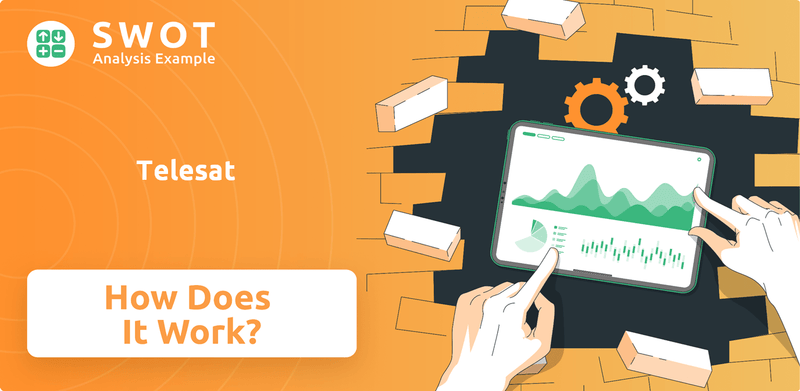
Understanding How Telesat works is crucial, especially with its ambitious Lightspeed Low Earth Orbit (LEO) satellite constellation. This project promises fiber-like speeds and extensive global coverage, potentially reshaping the landscape of satellite communications. From its legacy geostationary (GEO) business to its investment in Telesat LEO satellites, the company's evolution is a compelling story for investors and industry watchers alike.
What Are the Key Operations Driving Telesat’s Success?
The Telesat company creates value through its extensive satellite fleet, offering critical connectivity solutions worldwide. Its core operations revolve around providing satellite-based broadband internet, video distribution, and data communications to a diverse customer base, including businesses, governments, and communities. A key operational focus is the management and optimization of its existing GEO satellite capacity to ensure continuous service delivery to its established customer base. This approach allows Telesat to maintain reliable satellite services and meet the evolving demands of its clients.
The company's value proposition is significantly enhanced by its ongoing development of Telesat Lightspeed, an advanced LEO satellite constellation. This next-generation network aims to provide enterprise-class connectivity, offering fiber-like speeds with ubiquitous, affordable, high-capacity, secure, and resilient links. The operational processes for Lightspeed involve sophisticated technology development, including the deployment of a Constellation Network Operating System (CNOS) that leverages machine learning and AI for efficient, real-time network orchestration. This advanced software platform is crucial for managing the dynamic topology of LEO networks and ensuring high quality of service.
The development of Telesat's global network and its services is a strategic move to capture a larger share of the growing satellite communications market. The company's focus on innovation and strategic partnerships positions it well to compete in the rapidly evolving space technology sector. This includes addressing the needs of businesses and governments for robust and reliable connectivity solutions.
Optimizing existing GEO satellite capacity is crucial for Telesat. This ensures continuous service delivery to current customers. It involves managing bandwidth, addressing technical issues, and adapting to changing market demands.
Lightspeed is designed to offer enterprise-class connectivity. It aims to provide fiber-like speeds with ubiquitous, affordable, high-capacity, secure, and resilient links. The CNOS uses machine learning and AI for efficient network orchestration.
Strategic partnerships are vital for Telesat's operations. MDA Space was selected as the prime satellite contractor in 2023 for the Lightspeed program. MDA Space is also expanding its manufacturing capacity.
The Lightspeed project has secured significant funding. The Canadian and Quebec governments provided $2.54 billion in loan financing. This ensures sufficient funds for capital expenditures.
The core operational processes of Telesat involve managing its existing GEO satellite fleet and developing the Lightspeed LEO constellation. These processes include technology development, network management, and strategic partnerships. The company focuses on delivering reliable Telesat broadband internet and other satellite services.
- GEO Satellite Management: Ensuring continuous service delivery.
- Lightspeed Development: Deploying an advanced LEO constellation.
- CNOS Implementation: Utilizing AI for network orchestration.
- Strategic Partnerships: Collaborating with key suppliers.
Telesat SWOT Analysis
- Complete SWOT Breakdown
- Fully Customizable
- Editable in Excel & Word
- Professional Formatting
- Investor-Ready Format
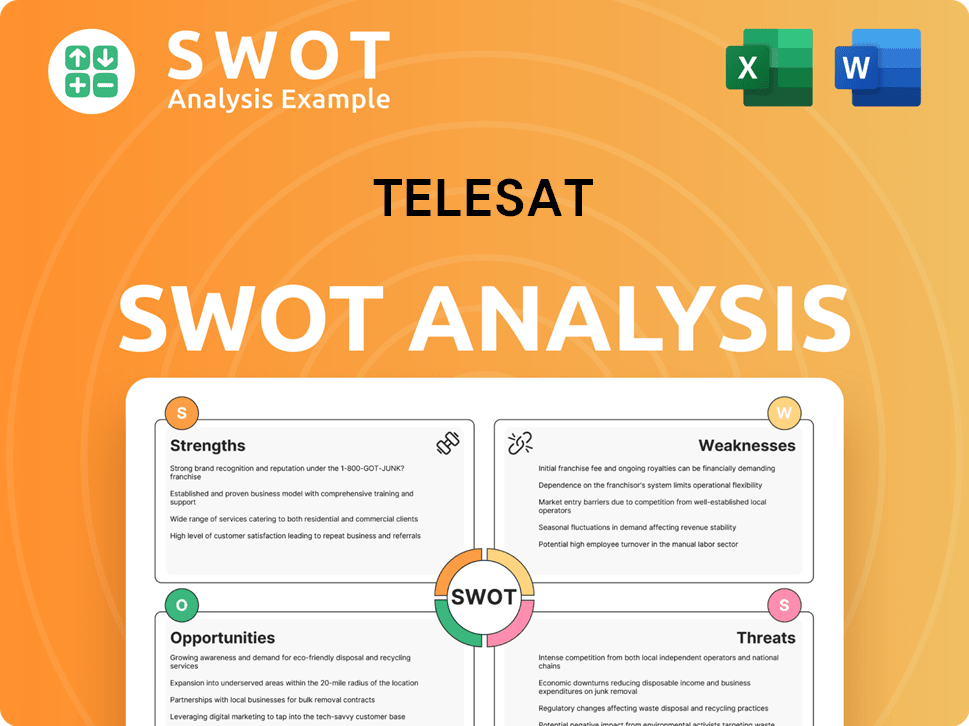
How Does Telesat Make Money?
The Telesat company generates revenue primarily through its satellite services, including broadband internet, video distribution, and data communications. Its revenue streams are largely based on long-term contracts with a diverse customer base. This base includes direct-to-home (DTH) television providers, enterprises, and government entities.
The company's financial performance has seen fluctuations, with a shift towards new technologies. The company is adapting to market changes by focusing on its upcoming Telesat Lightspeed LEO constellation. This transition is key to its future monetization strategies, aiming to secure long-term agreements with major clients in various sectors.
For the quarter ending March 31, 2025, Telesat reported consolidated revenue of $117 million, a 23% decrease compared to the same period in 2024. This decline was mainly due to factors such as a lower rate on the renewal of a long-term agreement with a North American DTH television customer and lower equipment sales to Canadian government customers. For the full year 2024, consolidated revenue was $571 million, a decrease of 19% from the prior year. The company anticipates full-year 2025 revenues to be between $405 million and $425 million, reflecting a projected 26% decline from 2024.
Despite the near-term revenue challenges in its legacy GEO business, Telesat is strategically shifting its monetization focus towards the Telesat Lightspeed LEO constellation. This program aims to secure multi-year agreements with large customers. This shift is crucial for long-term growth and competitiveness within the satellite communications industry. The company's approach involves offering enterprise-class connectivity with features like dynamic bandwidth allocation and edge computing integration.
- The LEO backlog reached nearly $1.1 billion as of May 5, 2025, indicating a growing future revenue stream. This is expected to exceed the year-end 2024 GEO segment backlog.
- Recent partnerships with companies such as Viasat, Orange, ADN Telecom, and Arabsat demonstrate the growing commercial traction for Lightspeed services.
- The company is targeting sectors such as telecom, government, maritime, and aeronautical to secure multi-year agreements.
- Telesat's focus on enterprise-class connectivity with features like dynamic bandwidth allocation and edge computing integration is designed to meet the demanding requirements of its target markets.
Telesat PESTLE Analysis
- Covers All 6 PESTLE Categories
- No Research Needed – Save Hours of Work
- Built by Experts, Trusted by Consultants
- Instant Download, Ready to Use
- 100% Editable, Fully Customizable
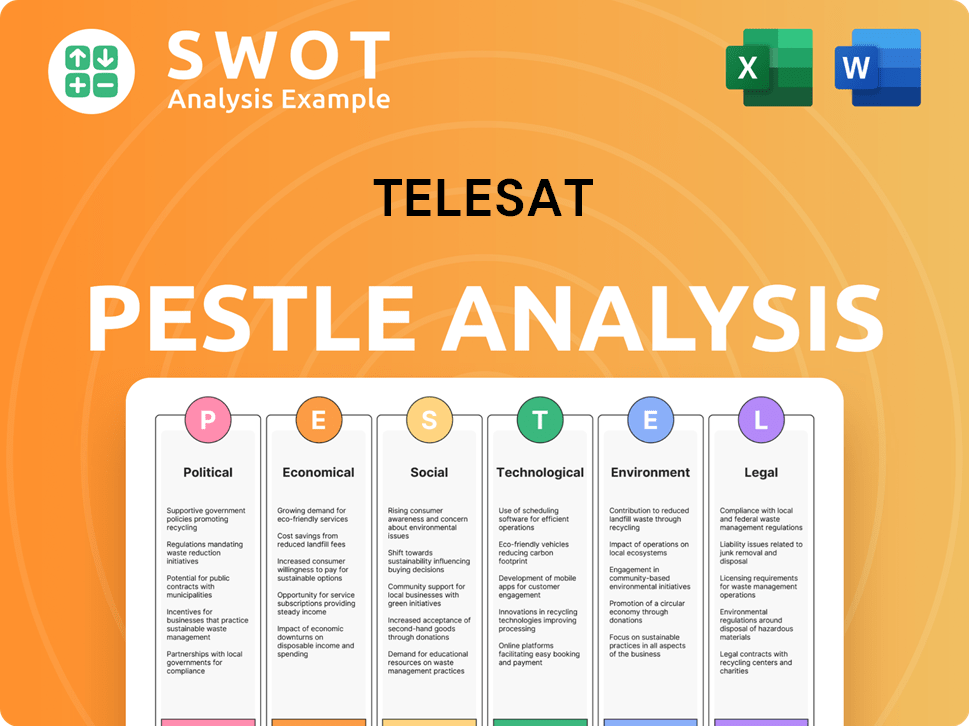
Which Strategic Decisions Have Shaped Telesat’s Business Model?
The Telesat company has navigated significant milestones, strategic shifts, and competitive pressures, particularly in the development of its Lightspeed Low Earth Orbit (LEO) constellation. These developments have been critical to its operations and financial standing. The successful completion of the spacecraft Preliminary Design Review (PDR) in December 2024 marked a major step towards full-scale development, demonstrating the maturity of the design.
A key strategic move was securing substantial financing to support the Lightspeed constellation. The company is also adapting to new trends and technology shifts by leveraging its CNOS software, which incorporates machine learning and AI for efficient network orchestration, a critical feature for the dynamic LEO network topology. Despite facing operational challenges and intense competition, Telesat is focused on disciplined execution in its GEO segment while building and commercializing Lightspeed.
The company's competitive advantages stem from its legacy of engineering excellence, reliability, and industry-leading customer service in its GEO business, combined with the innovative capabilities of the Lightspeed constellation. Recent strategic partnerships highlight Telesat's ability to attract significant commercial interest and build a substantial LEO backlog.
In December 2024, Telesat completed the spacecraft Preliminary Design Review (PDR), a crucial step for its Lightspeed LEO constellation. In 2023, MDA Space was selected as the prime satellite contractor, with an initial order for 198 satellites. These milestones are crucial for the advancement of the Telesat LEO satellites and their satellite services.
A major strategic move was securing $2.54 billion in loan financing from the Canadian and Quebec governments in September 2024. The company increased its workforce by approximately 33% in the 12 months prior to September 2024 to support Lightspeed. These moves are vital for Telesat's future plans and its satellite communications capabilities.
Telesat's competitive edge stems from its legacy in GEO services and the innovative Lightspeed constellation. Partnerships with Space Norway, Orange, and others highlight its ability to attract commercial interest. The company's CNOS software, which incorporates machine learning and AI for efficient network orchestration, provides a competitive advantage in the space technology sector.
The company faces operational challenges, including revenue declines in its legacy GEO business and competition from Starlink and Amazon Kuiper. Telesat has a substantial LEO backlog of nearly $1.1 billion. The company plans to begin launching Lightspeed satellites in 2026, with commercial services expected to start in late 2027. For more information on the Telesat target market, read this article: Target Market of Telesat.
Telesat is leveraging its CNOS software, which incorporates machine learning and AI for efficient network orchestration, a critical feature for the dynamic LEO network topology. Lightspeed is designed to offer high-capacity, low-latency, and secure connectivity, optimized for telecom, government, maritime, and aeronautical customers.
- High-capacity, low-latency connectivity.
- Optimized for telecom, government, maritime, and aeronautical customers.
- CNOS software with machine learning and AI for network orchestration.
- Focus on both GEO and LEO services.
Telesat Business Model Canvas
- Complete 9-Block Business Model Canvas
- Effortlessly Communicate Your Business Strategy
- Investor-Ready BMC Format
- 100% Editable and Customizable
- Clear and Structured Layout
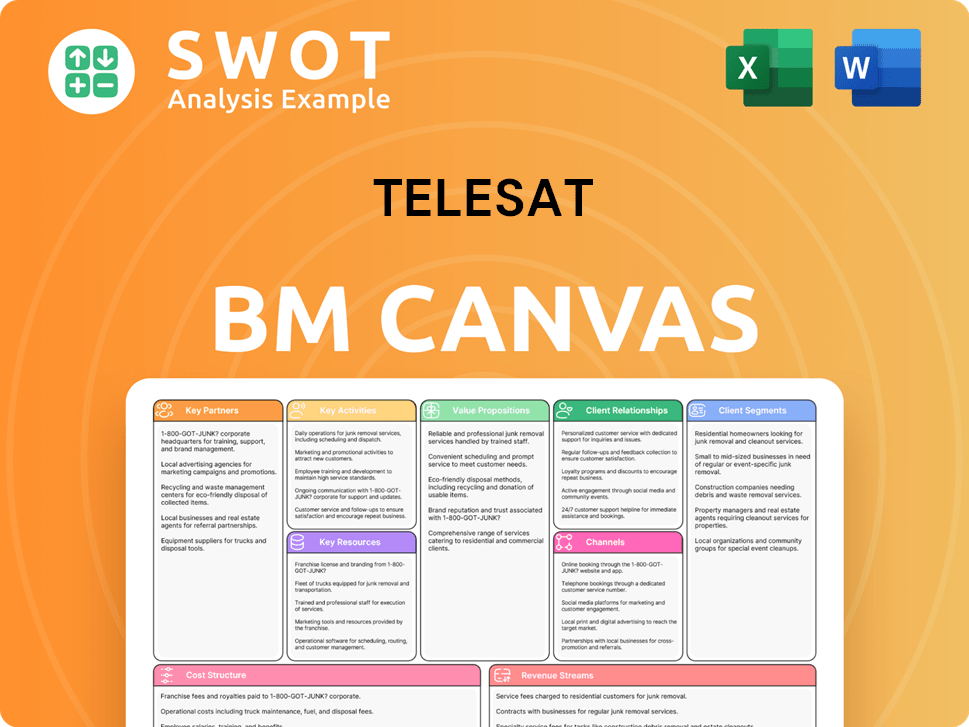
How Is Telesat Positioning Itself for Continued Success?
As a major player in the satellite industry, the Telesat company holds a significant position. The fixed satellite services market is valued at approximately USD 16.8 billion in 2024 and is projected to reach around USD 26.2 billion by 2033. However, Telesat faces challenges, particularly in the rapidly evolving LEO satellite space.
Key risks include revenue erosion in its legacy GEO satellite business, which declined 23% in the first quarter of 2025 compared to the same period last year. Refinancing risks, inflation, rising interest rates, and technological hurdles add to the challenges. Despite these issues, Telesat is pushing forward with its strategic initiatives, focusing on the development and deployment of Telesat Lightspeed.
Telesat is a prominent global satellite operator within the satellite communications sector. The company competes with established players and emerging LEO satellite constellations.
Telesat faces risks from declining GEO revenues and significant refinancing needs. Additional risks include inflation, interest rates, and technological challenges.
Telesat is focused on deploying Lightspeed. The company aims to redefine global satellite connectivity with its new LEO constellation.
The company secured $2.54 billion in loan financing in September 2024 to fully fund the LEO project. Leadership is confident in the Lightspeed program, with the LEO backlog reaching nearly $1.1 billion by May 2025.
Telesat is responding to market dynamics by investing in its Lightspeed LEO constellation. This project aims to provide high-capacity, secure, and resilient links. The company's strategy is focused on maintaining and expanding its revenue generation capabilities for the long term.
- Telesat is competing with companies like SpaceX's Starlink and Amazon's Project Kuiper.
- The company is using advanced technologies like machine learning and AI for network orchestration.
- Telesat's forward-looking perspective centers on redefining global satellite connectivity.
- For more insights, read about the Growth Strategy of Telesat.
Telesat Porter's Five Forces Analysis
- Covers All 5 Competitive Forces in Detail
- Structured for Consultants, Students, and Founders
- 100% Editable in Microsoft Word & Excel
- Instant Digital Download – Use Immediately
- Compatible with Mac & PC – Fully Unlocked
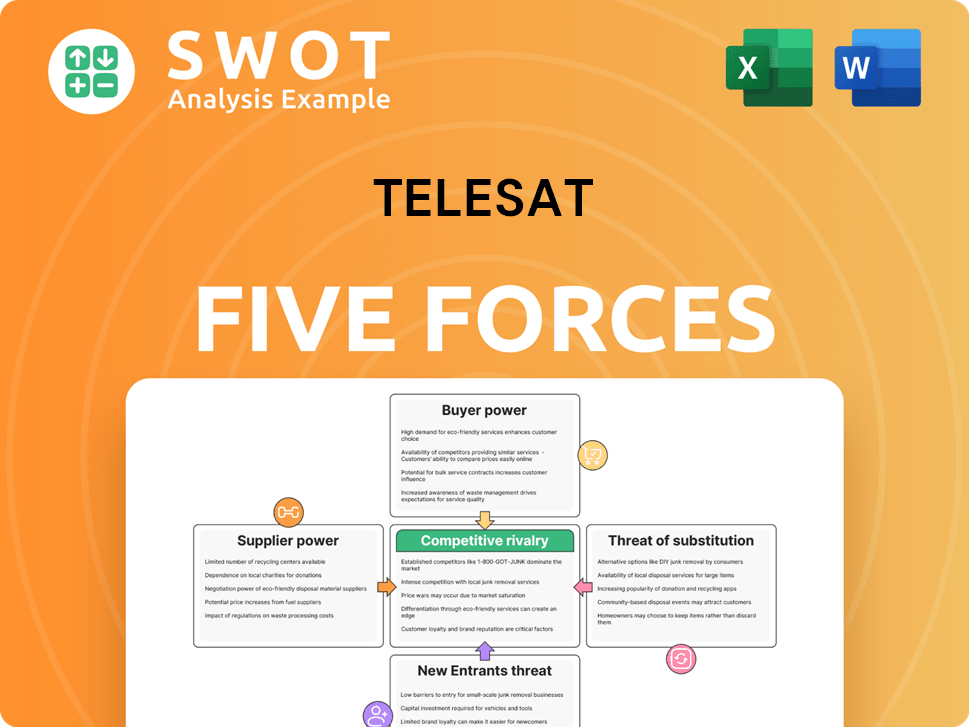
Related Blogs
- What are Mission Vision & Core Values of Telesat Company?
- What is Competitive Landscape of Telesat Company?
- What is Growth Strategy and Future Prospects of Telesat Company?
- What is Sales and Marketing Strategy of Telesat Company?
- What is Brief History of Telesat Company?
- Who Owns Telesat Company?
- What is Customer Demographics and Target Market of Telesat Company?
Disclaimer
All information, articles, and product details provided on this website are for general informational and educational purposes only. We do not claim any ownership over, nor do we intend to infringe upon, any trademarks, copyrights, logos, brand names, or other intellectual property mentioned or depicted on this site. Such intellectual property remains the property of its respective owners, and any references here are made solely for identification or informational purposes, without implying any affiliation, endorsement, or partnership.
We make no representations or warranties, express or implied, regarding the accuracy, completeness, or suitability of any content or products presented. Nothing on this website should be construed as legal, tax, investment, financial, medical, or other professional advice. In addition, no part of this site—including articles or product references—constitutes a solicitation, recommendation, endorsement, advertisement, or offer to buy or sell any securities, franchises, or other financial instruments, particularly in jurisdictions where such activity would be unlawful.
All content is of a general nature and may not address the specific circumstances of any individual or entity. It is not a substitute for professional advice or services. Any actions you take based on the information provided here are strictly at your own risk. You accept full responsibility for any decisions or outcomes arising from your use of this website and agree to release us from any liability in connection with your use of, or reliance upon, the content or products found herein.